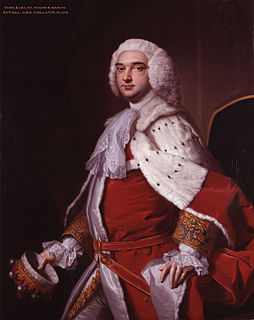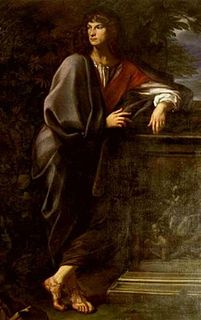Related Research Articles

Earl of Lichfield is a title that has been created three times, twice in the Peerage of England and once in the Peerage of the United Kingdom (1831). The third creation is extant and is held by a member of the Anson family.

Wills Hill, 1st Marquess of Downshire,, known as the Viscount Hillsborough from 1742 to 1751 and as the Earl of Hillsborough from 1751 to 1789, was a British politician of the Georgian era.

Marquess of the County of Bute, shortened in general usage to Marquess of Bute, is a title in the Peerage of Great Britain. It was created in 1796 for John Stuart, 4th Earl of Bute.

Marquess of Waterford is a title in the Peerage of Ireland and the premier marquessate in that peerage. It was created in 1789 for George Beresford, 2nd Earl of Tyrone. It is presently held by Henry Beresford, 9th Marquess of Waterford.

Viscount Bolingbroke is a current title in the Peerage of Great Britain created in 1712 for Henry St John. He was simultaneously made Baron St John, of Lydiard Tregoze in the County of Wilts. Since 1751 the titles are merged with the titles of Viscount St John and Baron St John in the same peerage.

Earl of Powis (Powys) is a title that has been created three times. The first creation came in the Peerage of England in 1674 in favour of William Herbert, 3rd Baron Powis, a descendant of William Herbert, 1st Earl of Pembroke. In 1687, he was further honoured when he was made Marquess of Powis.

John Perceval, 2nd Earl of Egmont, PC, FRS was a British politician, political pamphleteer, and genealogist who served as First Lord of the Admiralty.

Earl of Sunderland is a title that has been created twice in the Peerage of England. The first creation came in 1627 in favour of Emanuel Scrope, 12th Baron Scrope of Bolton. The earldom became extinct on his death in 1630 while the barony became either extinct or dormant. The second creation came in 1643 in favour of the Royalist soldier Henry Spencer, 3rd Baron Spencer of Wormleighton. The Spencer family descended from Sir John Spencer who acquired the Wormleighton estate in Warwickshire and the Althorp estate in Northamptonshire. His grandson Sir John Spencer was a Knight of the Shire for Northamptonshire. The latter's grandson Sir Robert Spencer represented Brackley in Parliament in the late 16th century. In 1603 Sir Robert was raised to the Peerage of England as Baron Spencer of Wormleighton. He was succeeded by his eldest surviving son, William, the second Baron. He had previously represented Northamptonshire in Parliament. His eldest son was the aforementioned third Baron. In July 1643 he was created Earl of Sunderland in the Peerage of England. Lord Sunderland was killed at the Battle of Newbury in September of the same year. He was succeeded by his two-year-old only son, Robert, the second Earl. He later gained great distinction as a statesman and notably served four times as Secretary of State for the Southern Department.

Lieutenant-General James FitzGerald, 1st Duke of Leinster, PC (Ire), styled Lord Offaly until 1744 and known as The Earl of Kildare between 1744 and 1761 and as The Marquess of Kildare between 1761 and 1766, was an Irish nobleman, soldier and politician.

Earl of Cavan is a title in the Peerage of Ireland. It was created in 1647 for Charles Lambart, 2nd Baron Lambart. He was made Viscount Kilcoursie, in the King's County, at the same time, also in the Peerage of Ireland. Lord Cavan was the son of Oliver Lambart, who had been elevated to the Peerage of Ireland as Lord Lambart, Baron of Cavan in the County of Cavan, in 1618.

George Henry Lee II, 3rd Earl of Lichfield PC (1718–1772) was a British politician and peer. He was made a Privy Councillor and Captain of the Gentlemen-at-Arms in 1762, holding both honours until death. Previously, he had served as Member of Parliament for Oxfordshire from 1740 until acceding to the peerage in 1743.

George de la Poer Beresford, 1st Marquess of Waterford, KP, PC (Ire) was an Irish politician, known as George Beresford, 2nd Earl of Tyrone from 1763 to 1789.

Thomas Taylour, 1st Earl of Bective, KP, PC (Ire) was an Irish peer and politician.
There have been three baronetcies created for members of the Gore family, all in the Baronetage of Ireland. All three titles are extant. The family also holds two earldoms and a barony.

Arthur Saunders Gore, 2nd Earl of Arran KP, PC (Ire) styled The Honourable Arthur Gore from 1758 to 1762 and Viscount Sudley from 1762 to 1773, was an Irish peer and politician.
Gentleman of the Bedchamber was a title in the royal household of the Kingdom of England from the 11th century, later used also in the Kingdom of Great Britain.

Barrells Hall is a large house in the Warwickshire countryside near Henley-in-Arden. The nearest village is Ullenhall, which for many years was the estate village, large parts of it having been built by the owners of Barrells Hall, the Newtons, one of the families who formerly owned Barrells. An adjacent house named Barrells Park was built in about 1950 on part of the Barrells estate.

Robert Walpole, 1st Earl of Catherlough, KB, (1702–1772), was a British Member of Parliament for Great Grimsby, Castle Rising, Norfolk (1747–54) and Milborne Port, Somerset (1770–72). He became successively Baron Luxborough (1745), Viscount Barrells and Earl of Catherlough, all titles within the peerage of Ireland. His wife, Henrietta Lady Luxborough, later became well known as a lady of letters, poet and pioneering landscape gardener.

Henrietta Knight, Baroness Luxborough, was an English poet and letter writer.

The Anson family is a British aristocratic family. Over time, several members of the Anson family were made knights, baronets and peers. Hereditary titles held by the Anson family include the earldom of Lichfield and the Anson baronetcy. Over time, several members of the family have risen to prominence, including Admiral of the Fleet George Anson, 1st Baron Anson, PC, FRS (1697–1762) and the society photographer Patrick Anson, 5th Earl of Lichfield (1939–2005).
References
- ↑ "No. 8556". The London Gazette . 26 July 1746. p. 2.
- ↑ "No. 10308". The London Gazette . 30 April 1763. p. 5.